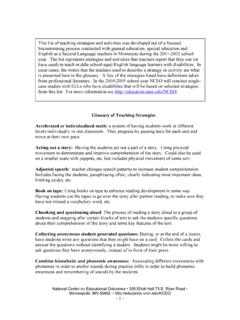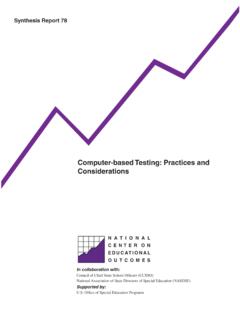Transcription of Students with Disabilities and Chronic Absenteeism - NCEO
1 1 NCEO Brief Number 15 April 2018 Chronic Absenteeism is gaining attention as states begin implementation of new statewide accountability systems under the Every Student Succeeds Act (ESSA), the latest version of the Elementary and Secondary Education Act. ESSA requires states to include one or more measures of school quality or student success in their accountability system used to annually differentiate public school performance (20 6311[c][4][B][v]). To meet this new requirement, designed to expand beyond test-based accountability systems, many states have chosen to measure student Chronic Absenteeism (Jordan & Miller, 2017). This enhanced focus on Absenteeism holds both promise and potential challenges, particularly as it relates to some Students with Disabilities .
2 Students with Disabilities & Chronic Absenteeism2 The purpose of this Brief is to provide information about Chronic Absenteeism and possible implications for Students with Disabilities when a state selects it as a measure of school quality or student success. It highlights both the benefits and potential risks in light of requirements in the Individuals with Disabilities Education Act (IDEA), Section 504 of the Rehabilitation Act of 1973 (Section 504), and the Americans with Disabilities Act (ADA). The Brief also suggests actions that states might consider taking to address Chronic absences among Students with Disabilities at the state and local levels as they work to include this new measure in accountability systems.
3 For purposes of this Brief, Students with Disabilities are those eligible for special education and related services under IDEA. What is Chronic Absenteeism ? Chronic Absenteeism is a measure of how many Students miss a defined number of school days for any reason excused, unexcused, suspension. Many states define Chronic Absenteeism as the number and percentage of Students missing 10 percent or more of their school days in a year. For a typical school year of 180 days, this means missing 18 or more days or an average of 2 days per month. However, the definition, and the number of days varies from state to state. Generally, Students who are chronically absent include Students absent for any reason ( , illness, suspension, the need to care for a family member), regardless of whether the absences are excused or districts were required to report the percentage of Students in each school who miss 15 or more days during the school year as part of the Department of Education s Civil Rights Data Collection (CRDC) for the first time in 2013-2014.
4 ESSA requires this information to be included in annual state and local district report Do We Know about Chronic Absenteeism ?There is a clear relationship between attendance and achievement. In 2016, the Department of Education reported that: Children who are chronically absent in preschool, kindergarten, and first grade are much less likely to read on grade level by the third grade. Students who cannot read at grade level by the third grade are four times more likely to drop out of high school. By high school, regular attendance is a better dropout indicator than test scores. A student who is chronically absent in any year between the eighth and twelfth grade is seven times more likely to drop most recent national data available (CRDC, 2013-14), showed that about 14% of Students missed 15 or more school days.
5 Nearly 10,000 schools reported 30% or more of Students as chronically absent. Elementary schools generally had lower average rates of Chronic absences (11%) than high schools (19%). Schools with higher percentages of economically disadvantaged Students had Source: Future Ed (2017), analysis of state ESSA addition to Chronic Absenteeism , other measures frequently used by states to measure attendance include: Average daily attendance (ADA), which measures the average number of Students who show up on any given day, but masks Students who are at risk of academic failure due to Chronic absences. Truancy rates, which include only unexcused absences. Truant Students generally face punitive consequences such as suspensions, academic sanctions, and with repeat offenses, referral to juvenile or family Chronic Absenteeism than other schools.
6 American Indian or Alaska Native, Native Hawaiian or other Pacific Islander, Black, multiracial, and Latino Students had higher rates of Chronic Absenteeism than other Students at both the elementary and high school of these reported 2013-14 rates may have been underreported because it was the first time schools were required to report on Absenteeism ; some schools may have not understood how to appropriately report these data at that time. Further, it is possible that the Chronic Absenteeism rate has increased since 2013-14; we do not have national data to help us understand whether these rates are increasing or Do We Know about Chronic Absenteeism Among Students with Disabilities ?
7 The 2013-14 national data showed that elementary school Students with Disabilities served by IDEA were times as likely to be chronically absent as elementary school Students without Disabilities . High school Students with Disabilities served by IDEA were times as likely to be chronically absent as high school Students without Disabilities . Across subgroups, only Native Students (American Indian or Alaska Native and Native Hawaiian or other Pacific Islander) exceeded the rates of Chronic Absenteeism for Students with Disabilities . This disparity is echoed in more recent data collected by states. For example, connecticut s (2017) data for the 2015-2016 school year showed that Students with Disabilities served by IDEA continued to exhibit substantially higher Chronic Absenteeism rates than their general education peers despite statewide prevention and intervention efforts.
8 Eighteen percent of connecticut s Students with Disabilities were chronically absent compared to percent overall. ESSA requires states to disaggregate all measures used in statewide accountability systems by student subgroups (major racial and ethnic groups, economically disadvantaged, Students with Disabilities , and English learners). Thus, new (more recent) data on Chronic Absenteeism will provide extensive information about disparities across student groups. Many factors may contribute to higher rates of absences among Students with Disabilities . Among these are Chronic health conditions, fatigue and other side effects from medication, anxiety caused by bullying and harassment, inappropriate or inadequate special education and related services, trauma, food, and housing insecurity.
9 Many Students with Disabilities also receive developmental and supportive services and health related services from private therapists. To date there is little research to explain the significant gap in Chronic Absenteeism between Students with Disabilities and those without Disabilities . Some Students with Disabilities are fragile medically, or may have emotional or behavioral Disabilities that might affect attendance, but there currently is little data available about Chronic Absenteeism and these populations. A national data collection on the characteristics and experiences of youth in special education (Liscomb, Haimson, Liu, Burghardt, Johnson, & Thurlow, 2017) found a much higher occurrence of health conditions among special education Students .
10 Specifically, it reported that Chronic health conditions were nearly three times more common among youth with an Individualized Education Program (IEP) than among those without an IEP. Twenty-eight percent of youth with an IEP had a Chronic physical or mental health condition that required regular treatment or medical care according to parents, compared with 10% of their peers. The report also included that youth with an IEP were more likely than their peers to have poorer health, Chronic conditions, and behavioral issues that need to be controlled recent study looked at the variation in elementary school Students with Disabilities across five IDEA disability categories (Gottfried, Stiefel, Schwartz, & Hopkins, 2017).





